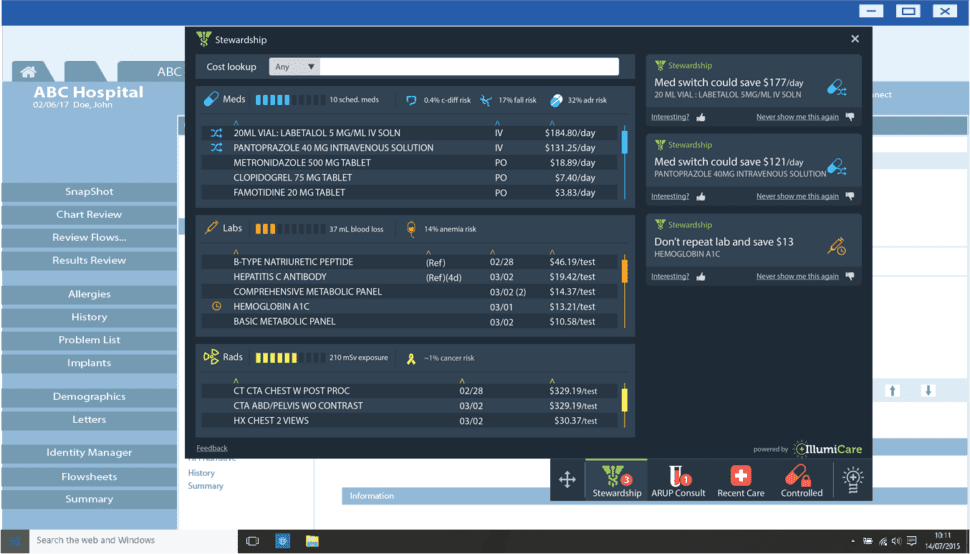See the first article in this series on lab testing and health IT.
Where doctors are reimbursed for each test, it’s well known that they order more tests than necessary. Over time, payers have tightened criteria for reimbursements. The difficult trick is to balance the value of a test against the cost, which comes out of the clinician’s bottom line.
Dr. Mukul Mehra, cofounder of Illumicare, says that many doctors, trying to track the progress of a patient, order follow-up tests that add little new information to the original test. Testing is also tiring to the patient, and repeated drawing of blood can weaken the patient.
Mehra also points out that cost control is not taught in medical school. Standards of care don’t specify what tests to order or how often.
Test Laboratories in the Hot Seat
Gregory Church, president of 4medica, told me that payers are squeezing laboratories as well. Even after a doctor has ordered a test and the lab has performed it, the payer might deem it unnecessary and refuse to pay the lab.
So Church says that labs are now collecting data about the patient in order to request pre-authorization from payers. If the lab decides that the clinic hasn’t sent enough patient information, they ask for more. Much of this data, like other medical information, goes by phone or fax. About 50% of the time, staff has to fill in information, increasing costs, chances of error, and irksome clerical burdens.
Like many recent insurance requirements that enterprising bean-counters hope will lower costs, this requirement for labs will probably increase them—along with threatening patient privacy by sharing their information more and more widely. What’s next? Will a payer refuse to reimburse a pharmacist for handing out the prescribed medication?
Data for Cost Reduction
Uncertainty can lead to either overtreatment or undertreatment. A doctor relying on their intuition and experience often can’t determine whether a test or a particular drug dose will help a particular patient. Better choices can be made by the accurate use of artificial intelligence to compare a patient to thousands of earlier patients.
Illumicare’s Smart Ribbon service guides hospitals on tests and treatments to reduce waste. Illumicare’s clients cull data from their EHRs to create databases of relevant patient data that Smart Ribbon can hook into. Smart Ribbon then summarizes information (Figure 1) and presents suggestions to doctors as they evaluate the need for a test of treatment. Occasionally, Smart Ribbon also writes information back to the EHR.

Smart Ribbon also draws insights from from clinical literature and data from its clinical partners.
Smart Ribbon’s findings might cause the doctor to forego a test or find a cheaper lab. The findings establish the costs of a test or treatment and bring risks to the surface.
Many hospitals run comparisons with other hospitals to see how well their doctors are doing at curing patients and controlling costs. Smart Ribbon can do this on a a very fine-grained level, telling a doctor how the treatment of a particular patient compares to treatment of comparable patients. They can compare predicted with actual lengths of stay, and remind clinicians of things that have to be done to reduce a stay. Thus, Mehra said they can speed up discharges and prevent readmissions.
Illumicare rolled out this service in 2016 as an experiment. But nowadays, given staffing shortages and other pressures on hospitals, many see the service as a must-have.
4medica works with both clinicians and labs to reduce unnecessary testing. Their service collects orders and other data from EHRs. Analytics can update the master patient index, check the accuracy of diagnostic and other information, and normalize coding. For instance, 4medica can question whether the test that was ordered make sense for the given diagnosis.
They provide a HIPAA-compliant portal for data transfer. They also support secondary data usage, providing data to clinicians and researchers. They’re adding support for genetic tests.
According to Gerry Miller, founder and CEO of Cloudticity, incremental testing is starting to take hold. The doctor orders an initial simple test, and if its results are abnormal, orders a second, more expensive test. Tests can be combined so that test equipment uses algorithms to decide whether to perform the higher-level test immediately.
The last article in the series will cover a few other companies who are finding more accurate tests, or faster ways of developing them.













